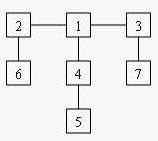题目链接:http://poj.org/problem?id=1655
Balancing Act
| Time Limit: 1000MS | Memory Limit: 65536K | |
| Total Submissions: 19110 | Accepted: 8083 |
Description
Consider a tree T with N (1 <= N <= 20,000) nodes numbered 1...N. Deleting any node from the tree yields a forest: a collection of one or more trees. Define the balance of a node to be the size of the largest tree in the forest T created by deleting that node from T.
For example, consider the tree:

Deleting node 4 yields two trees whose member nodes are {5} and {1,2,3,6,7}. The larger of these two trees has five nodes, thus the balance of node 4 is five. Deleting node 1 yields a forest of three trees of equal size: {2,6}, {3,7}, and {4,5}. Each of these trees has two nodes, so the balance of node 1 is two.
For each input tree, calculate the node that has the minimum balance. If multiple nodes have equal balance, output the one with the lowest number.
For example, consider the tree:

Deleting node 4 yields two trees whose member nodes are {5} and {1,2,3,6,7}. The larger of these two trees has five nodes, thus the balance of node 4 is five. Deleting node 1 yields a forest of three trees of equal size: {2,6}, {3,7}, and {4,5}. Each of these trees has two nodes, so the balance of node 1 is two.
For each input tree, calculate the node that has the minimum balance. If multiple nodes have equal balance, output the one with the lowest number.
Input
The first line of input contains a single integer t (1 <= t <= 20), the number of test cases. The first line of each test case contains an integer N (1 <= N <= 20,000), the number of congruence. The next N-1 lines each contains two space-separated node numbers that are the endpoints of an edge in the tree. No edge will be listed twice, and all edges will be listed.
Output
For each test case, print a line containing two integers, the number of the node with minimum balance and the balance of that node.
Sample Input
1 7 2 6 1 2 1 4 4 5 3 7 3 1
Sample Output
1 2
Source
树的重心:
找到一个点,其所有的子树中最大的子树节点数最少,那么这个点就是这棵树的重心,删去重心后,生成的多棵树尽可能平衡。
树的重心的性质:
1.树中所有点到某个点的距离和中,到重心的距离和是最小的;如果有两个重心,那么他们的距离和一样。
2.把两个树通过一条边相连得到一个新的树,那么新的树的重心在连接原来两个树的重心的路径上。
3.把一个树添加或删除一个叶子,那么它的重心最多只移动一条边的距离。
题目大意:给定一棵树,求树的重心的编号以及重心删除后得到的最大子树的节点个数size,如果size相同就选取编号最小的.
看代码:
#include<iostream> #include<cstdio> #include<cstdlib> #include<cstring> using namespace std; const int maxn=2e4+5; const int INF=1e9+7; int head[maxn<<1]; int sonnum[maxn<<1],sonmax[maxn]; int cnt; int N; struct Edge { int next,to;//next表示同起点的下一条边的下标 to表示这条边的终点 }e[maxn<<1]; void add_edge(int u,int v) { e[++cnt].to=v; e[cnt].next=head[u]; head[u]=cnt; } void dfs(int root,int pre) { sonnum[root]=1; for(int i=head[root];i!=-1;i=e[i].next) { int v=e[i].to; if(v==pre) continue; dfs(v,root); sonnum[root]+=sonnum[v];//总个数 sonmax[root]=max(sonmax[root],sonnum[v]);//最大子节点 } } int main() { int T;scanf("%d",&T); while(T--) { cnt=0; memset(head,-1,sizeof(head)); memset(sonmax,0,sizeof(sonmax)); memset(sonnum,0,sizeof(sonnum)); scanf("%d",&N); for(int i=1;i<N;i++) { int u,v;scanf("%d%d",&u,&v); add_edge(u,v); add_edge(v,u); } dfs(1,0); int mi=INF,pos; for(int i=1;i<=N;i++) { int ma=max(sonmax[i],N-sonnum[i]); if(ma<mi) { mi=ma; pos=i; } } printf("%d %d ",pos,mi); } return 0; }